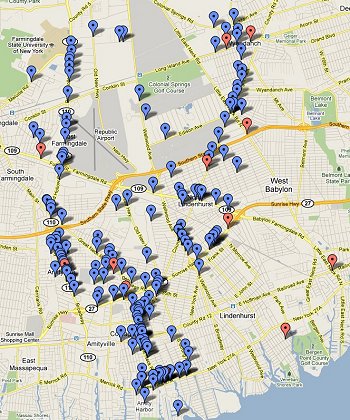Long Island Towns Pursue Complete Streets Despite Assembly Stalling
New York State still lacks a complete streets law, despite the bill’s overwhelming passage through the State Senate and the support of the Assembly’s Transportation Committee. After a series of amendments in June, the Assembly bill now matches the stronger Senate version, but is stuck in the Ways and Means Committee, chaired by Upper Manhattan rep Herman "Denny" Farrell.
 There were 424 pedestrian and cyclist injuries and crashes in the Town of Babylon between 2006 and 2008 alone. Image: TSTC
There were 424 pedestrian and cyclist injuries and crashes in the Town of Babylon between 2006 and 2008 alone. Image: TSTCIn the face of state inaction, Long Island’s local governments are taking street safety into their own hands, passing their own complete streets policies. However, there’s only so much that towns can do; some of their most dangerous streets are outside their jurisdiction. A comprehensive approach to street safety requires action from the Assembly.
The Town of Babylon, which encompasses several smaller communities and is home to more than 200,000 people, passed Long Island’s first complete streets policy earlier this month. The legislation acknowledges the town’s auto-dependency and Long Island’s history as a region that pioneered sprawl, while promising to move beyond that legacy. "This Policy will fundamentally change the relationship between driver and pedestrian by creating streets that regard these users equally, with equal right to access and use," reads the preface to the bill.
Any roadwork under the town’s jurisdiction — whether planning, repair, or new construction — must now be designed and executed to accommodate pedestrians of all abilities, cyclists, and public transportation. While not every street will have sidewalks or bike lanes, Babylon is committed to building "an interwoven array" of streets — networks for walking, bicycling, and transit so people can reach destinations safely and quickly without having to drive.
To ensure that the new policy has staying power, Babylon will develop a new Sustainable Complete Streets Master Plan within 18 months and evaluate its streets based on a new array of metrics, including the increase in walking and biking and the reduction in car speeds in pedestrian areas.
Babylon isn’t the only Long Island town working to complete its streets. Both Islip and Brookhaven, which cover big geographic areas and have the populations of medium-sized cities (around 300,000 and 450,000 people, respectively), will be voting on complete streets policies in August.
"Hopefully we’ll be the second town," said George Hoffman, the chief of staff for Islip Supervisor Phil Nolan. "It helps build walkable communities, it helps bikers, it helps seniors," Hoffman explained, adding that Islip modeled its complete streets policy after Babylon’s and that he believes the bill has strong support in the town council.
But these towns won’t be able to do everything on their own. As noted by the Ryan Lynch of the Tri-State Transportation Campaign, local complete streets laws can only require change on roads owned by the town itself or in private subdivisions. State and county roads like the Sunrise Highway, the second-most dangerous road in the region, would be exempt. Only 29 percent of Babylon’s pedestrian and cycling fatalities occurred along town roads, according to Tri-State.
That’s why the Assembly needs to pass a statewide complete streets bill. "That wold be the preferable way," said Hoffman, "since most all the roads have some sort of state funding in them." Hoffman added that any state law would be perfectly compatible with ongoing local efforts to improve street safety, and that concerns about imposing an unfunded mandate were unfounded. "If you get in at the planning stage," he explained, "a lot of this stuff is really not expensive."